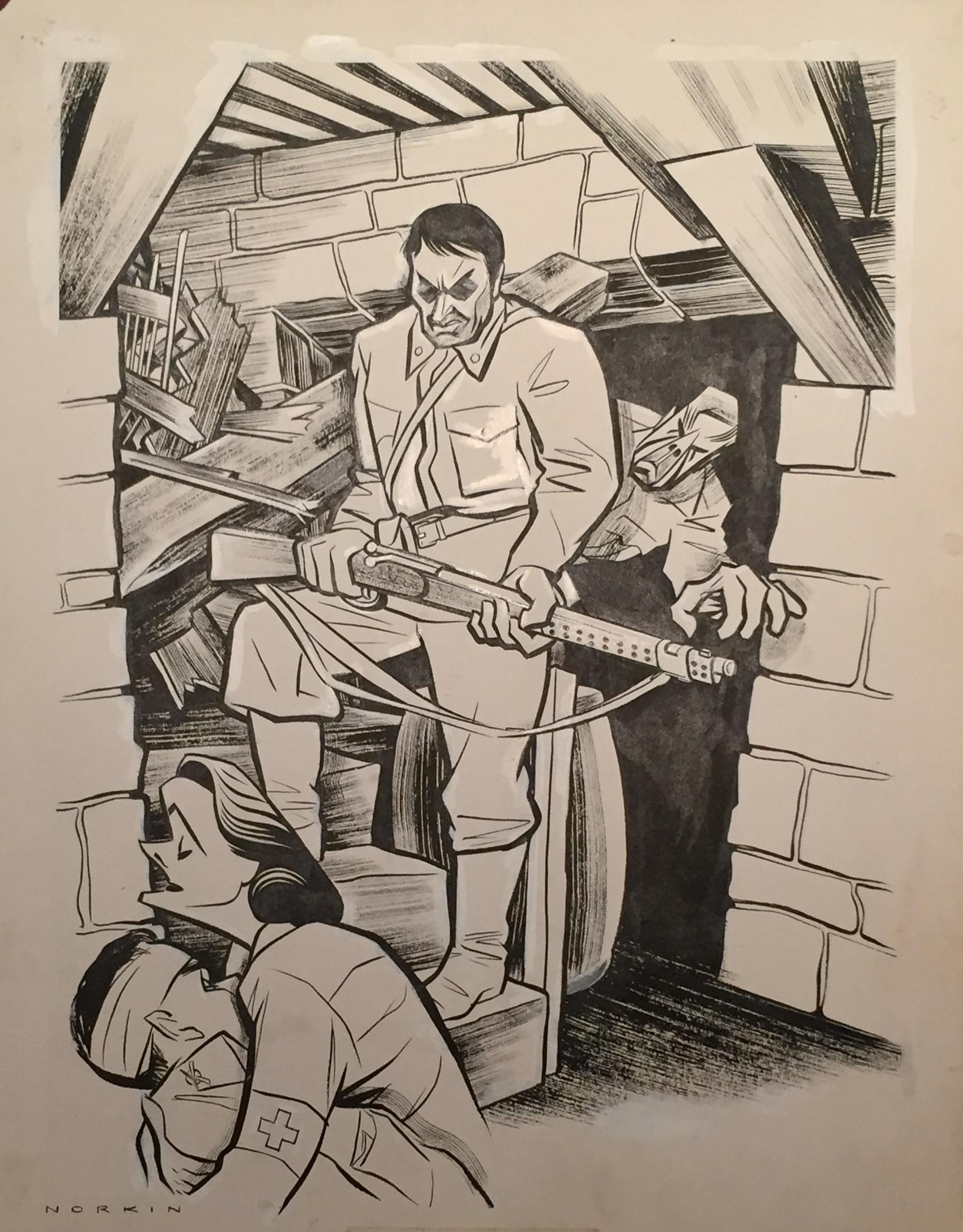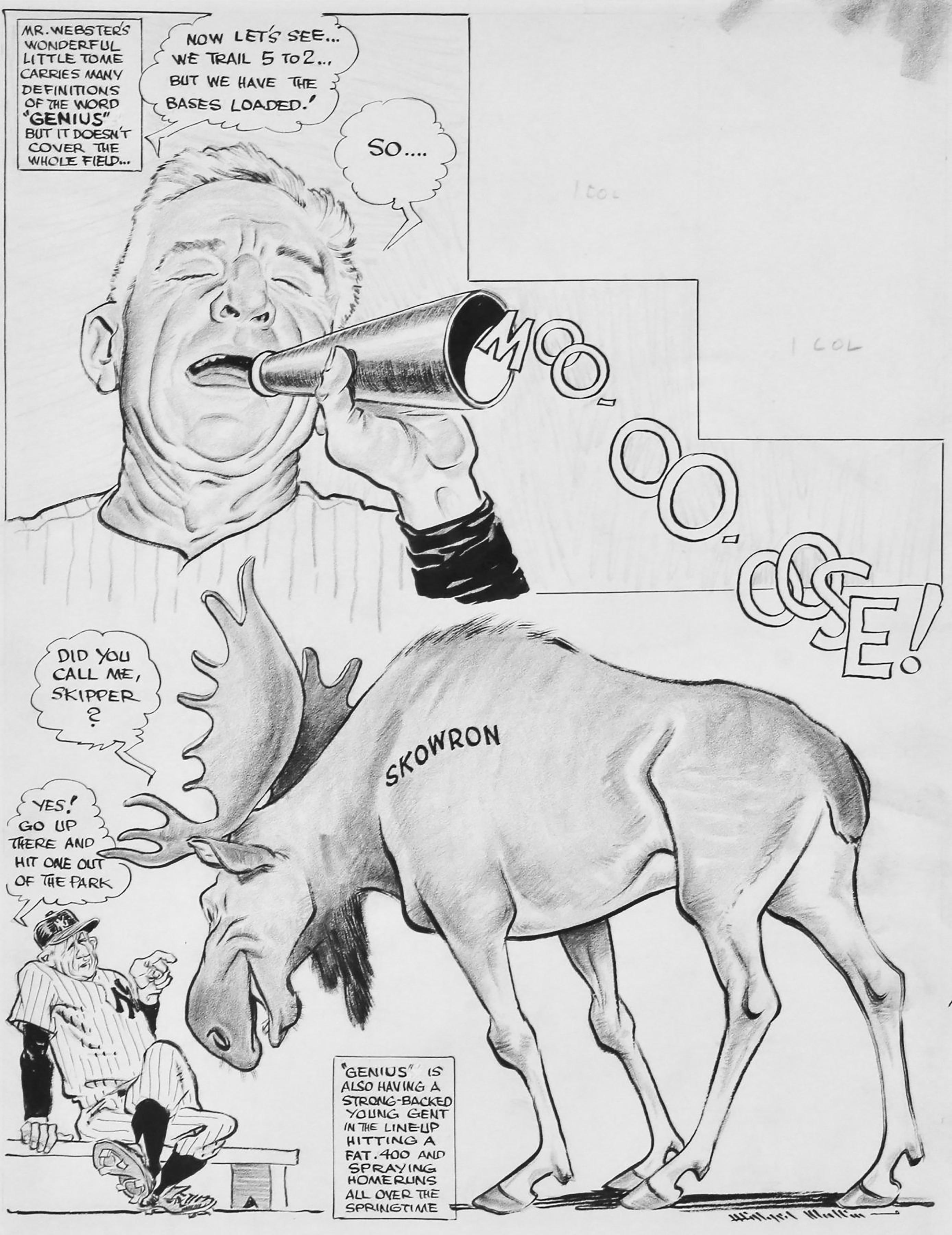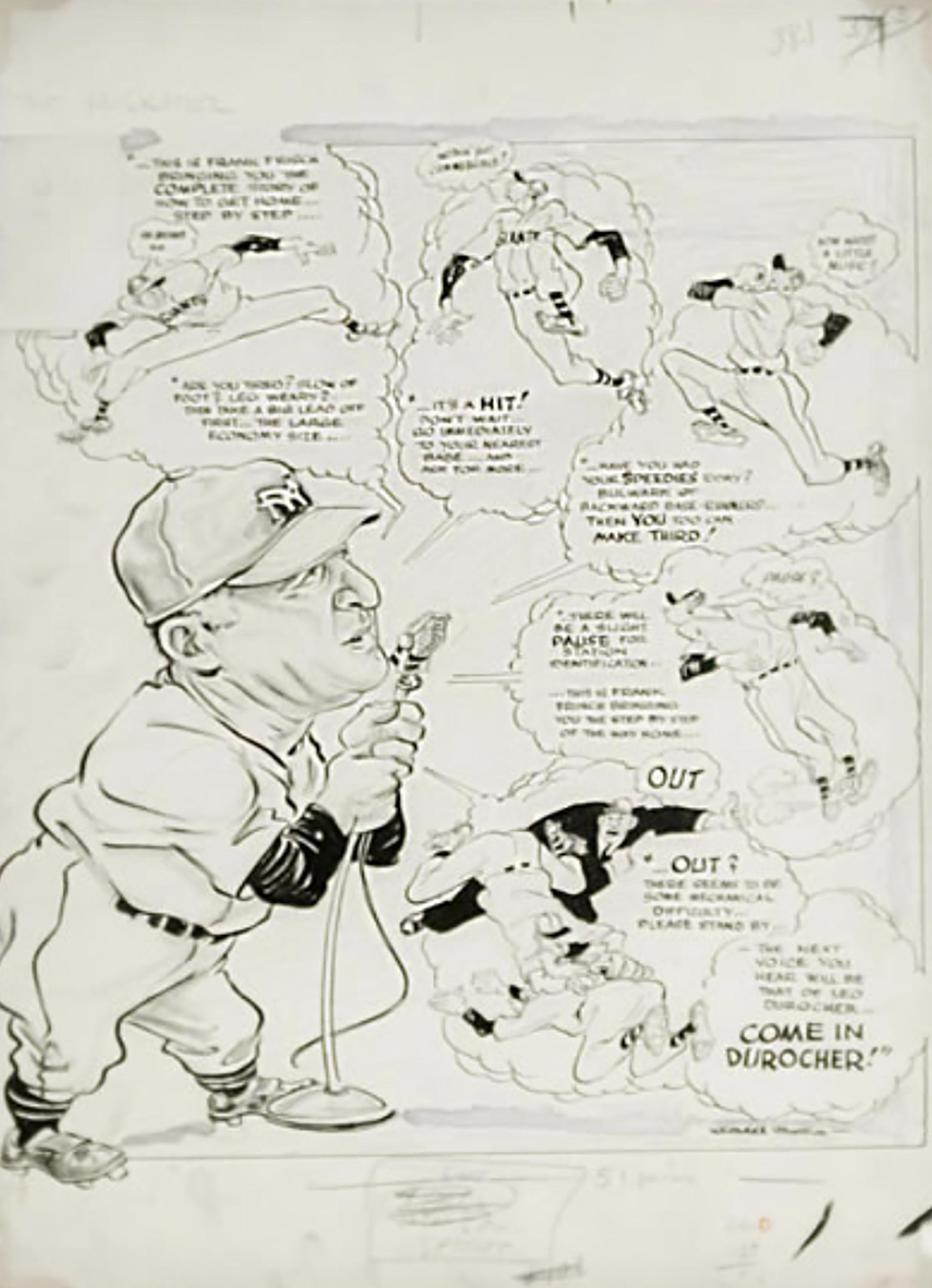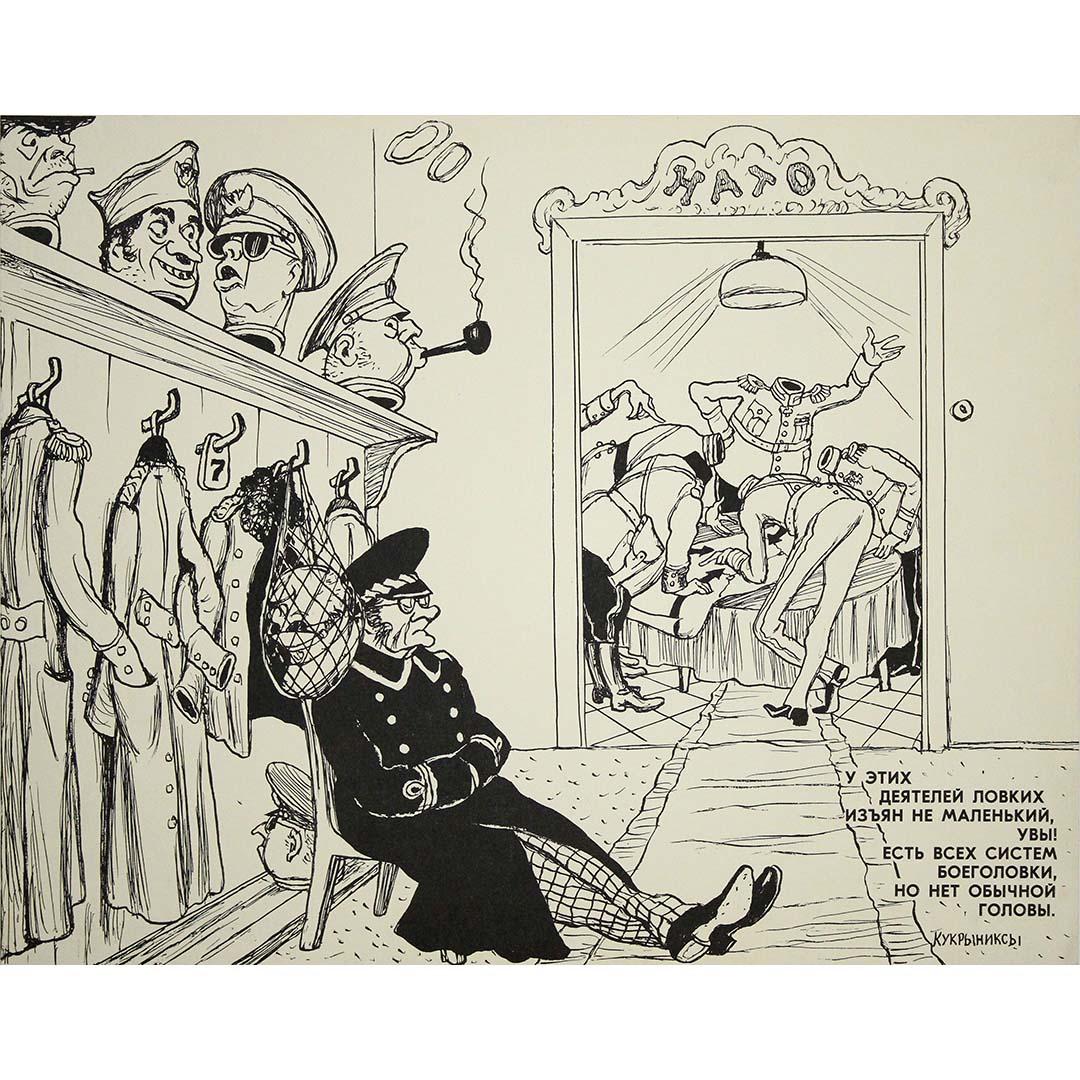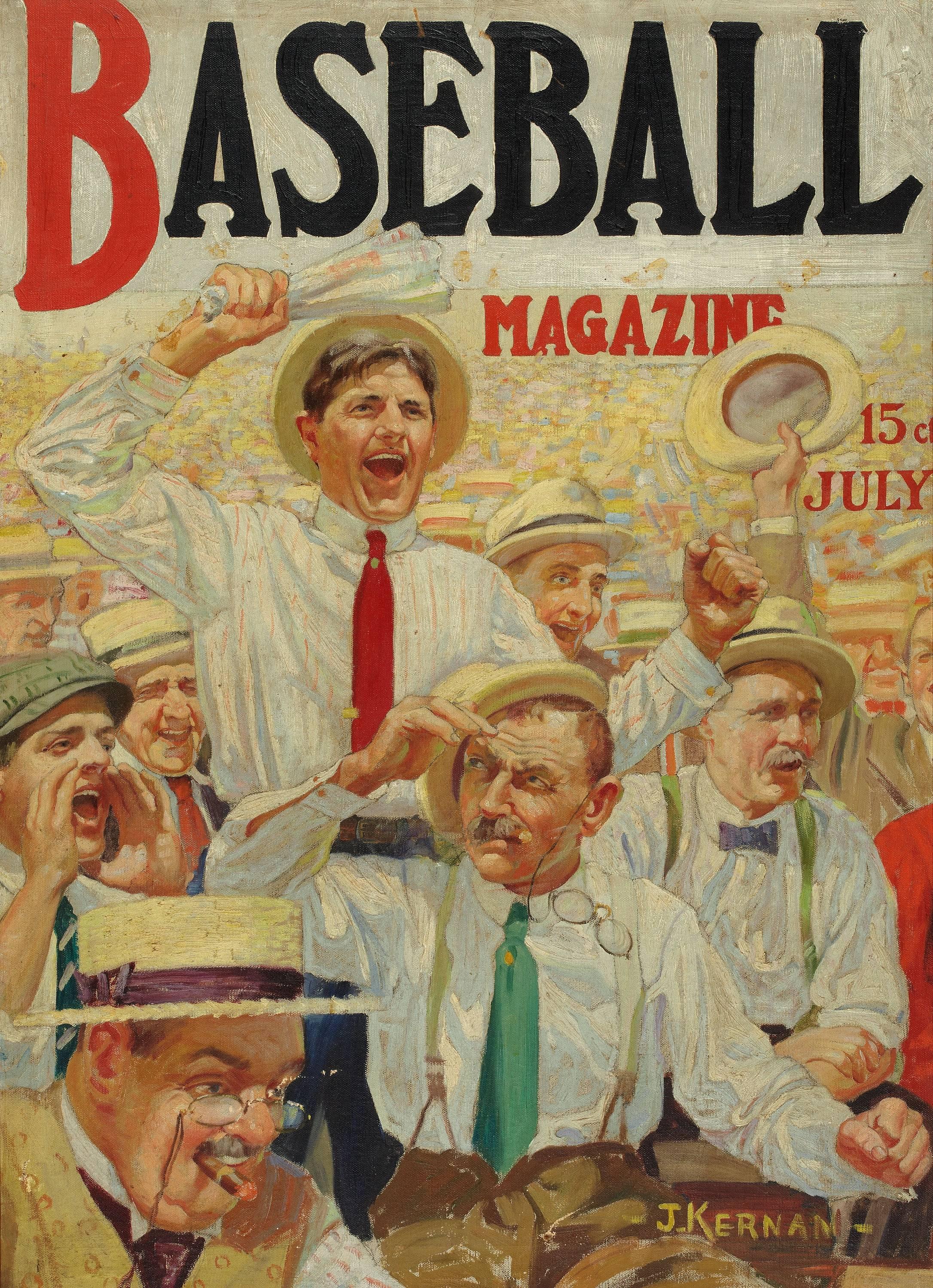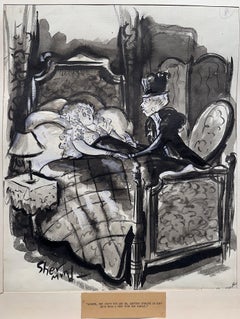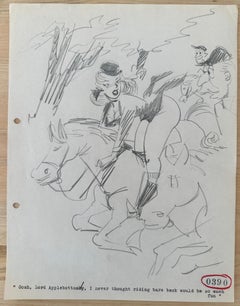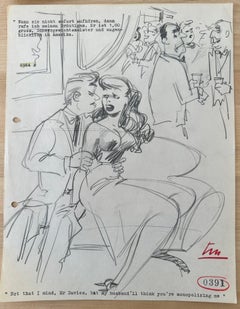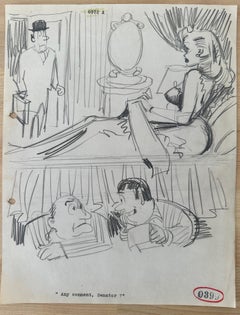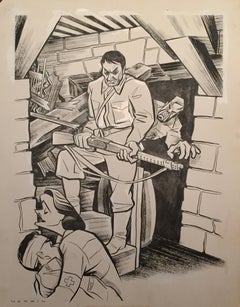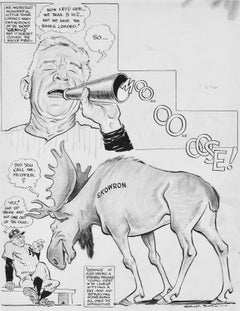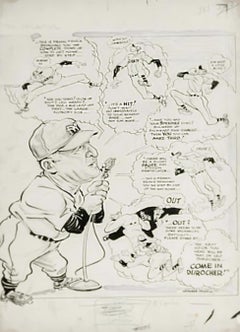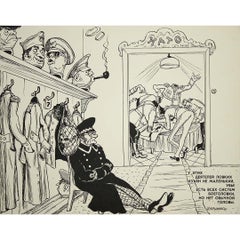Items Similar to Same Old Story (Brooklyn Dodgers & St. Louis Cardinals Illustration)
Want more images or videos?
Request additional images or videos from the seller
1 of 14
Bill CrawfordSame Old Story (Brooklyn Dodgers & St. Louis Cardinals Illustration)1943
1943
$1,200
£902.89
€1,042.86
CA$1,695.91
A$1,840.32
CHF 975.21
MX$22,570.68
NOK 12,068.15
SEK 11,403.76
DKK 7,785.44
About the Item
Bill Crawford (1913-1982). Original illustration artwork depicting teams as they advance to the World Series. Depicted are representations of the St. Louis Cardinals and The Brooklyn Dodgers. Artwork image measures 11.25 x 19 inches in a frame measuring 21.5 x 29 inches.
The dot patterns evident in close up pics reveal a stippled paper. These are not the dots of a photomechanical reproduction process. This example is an original, unique work of art.
Birth place: Hammond, IN
Addresses: Maplewood, NJ; NYC
Profession: Cartoonist, sculptor, illustrator, teacher
Studied: Chicago Acad Fine Arts; Ohio State Univ, BA, 1935; Acad. de la Grande Chaumière, Paris.
Exhibited: CMA, 1934 (prize); Italy, Paris, Israel. Awards: Best ed page cartoonist, Nat Cartoonists Soc, 1956-58, 1966.
Member: Nat Cartoonists Soc (pres, 1960-1961); Asn Am Ed Cartoonists.
Work: Syracuse Univ; LOC; cartoons, Canadian Pavilion, Montreal.
Comments: Positions: Ed cartoonist, Newark Eve News, NJ, 1938-61; chief ed cartoonist, Newspaper Enterprise Asn, NYC, 1962-70s. Publications: contribr, nat mags; illusr, Barefoot Boy with Cheek, 1943, Zebra Derby, 1946s. Teaching: Newark Sch Fine & Applied Arts; Rutgers Univ.
- Creator:Bill Crawford (1913 - 1982)
- Creation Year:1943
- Dimensions:Height: 29 in (73.66 cm)Width: 21.5 in (54.61 cm)Depth: 0.5 in (1.27 cm)
- Medium:
- Movement & Style:
- Period:
- Condition:
- Gallery Location:Wilton Manors, FL
- Reference Number:1stDibs: LU245214145112
About the Seller
4.9
Platinum Seller
Premium sellers with a 4.7+ rating and 24-hour response times
Established in 2007
1stDibs seller since 2015
418 sales on 1stDibs
Typical response time: 2 hours
- ShippingRetrieving quote...Shipping from: Wilton Manors, FL
- Return Policy
Authenticity Guarantee
In the unlikely event there’s an issue with an item’s authenticity, contact us within 1 year for a full refund. DetailsMoney-Back Guarantee
If your item is not as described, is damaged in transit, or does not arrive, contact us within 7 days for a full refund. Details24-Hour Cancellation
You have a 24-hour grace period in which to reconsider your purchase, with no questions asked.Vetted Professional Sellers
Our world-class sellers must adhere to strict standards for service and quality, maintaining the integrity of our listings.Price-Match Guarantee
If you find that a seller listed the same item for a lower price elsewhere, we’ll match it.Trusted Global Delivery
Our best-in-class carrier network provides specialized shipping options worldwide, including custom delivery.More From This Seller
View AllLife Magazine Satirical Society Cartoon Illustration
Located in Wilton Manors, FL
Barbara Shermund (1899-1978). Society Satirical Cartoon, ca. 1940s. Gouache on heavy illustration paper, image measures 17 x 14 inches; 23 x 20 inches in matting. Signed lower left. Very good condition but matting panel should be replaced. Unframed.
Provenance: Ethel Maud Mott Herman, artist (1883-1984), West Orange NJ.
For two decades, she drew almost 600 cartoons for The New Yorker with female characters that commented on life with wit, intelligence and irony.
In the mid-1920s, Harold Ross, the founder of a new magazine called The New Yorker, was looking for cartoonists who could create sardonic, highbrow illustrations accompanied by witty captions that would function as social critiques.
He found that talent in Barbara Shermund.
For about two decades, until the 1940s, Shermund helped Ross and his first art editor, Rea Irvin, realize their vision by contributing almost 600 cartoons and sassy captions with a fresh, feminist voice.
Her cartoons commented on life with wit, intelligence and irony, using female characters who critiqued the patriarchy and celebrated speakeasies, cafes, spunky women and leisure. They spoke directly to flapper women of the era who defied convention with a new sense of political, social and economic independence.
“Shermund’s women spoke their minds about sex, marriage and society; smoked cigarettes and drank; and poked fun at everything in an era when it was not common to see young women doing so,” Caitlin A. McGurk wrote in 2020 for the Art Students League.
In one Shermund cartoon, published in The New Yorker in 1928, two forlorn women sit and chat on couches. “Yeah,” one says, “I guess the best thing to do is to just get married and forget about love.”
“While for many, the idea of a New Yorker cartoon conjures a highbrow, dry non sequitur — often more alienating than familiar — Shermund’s cartoons are the antithesis,” wrote McGurk, who is an associate curator and assistant professor at Ohio State University’s Billy Ireland Cartoon Library & Museum. “They are about human nature, relationships, youth and age.” (McGurk is writing a book about Shermund.
And yet by the 1940s and ’50s, as America’s postwar focus shifted to domestic life, Shermund’s feminist voice and cool critique of society fell out of vogue. Her last cartoon appeared in The New Yorker in 1944, and much of her life and career after that remains unclear. No major newspaper wrote about her death in 1978 — The New York Times was on strike then, along with The Daily News and The New York Post — and her ashes sat in a New Jersey funeral...
Category
1940s Realist Figurative Paintings
Materials
Gouache
Humorous Gentleman's Magazine cartoon
Located in Wilton Manors, FL
Cartoon sketch, ca. 1955. Pencil on paper, sheet measures 8.5 x 11 inches. Unsigned with editor's notations.
From a group of sketches meant to be preliminary drafts for editor appro...
Category
Mid-20th Century Figurative Drawings and Watercolors
Materials
Pencil
$125 Sale Price
50% Off
Humorous Gentleman's Magazine cartoon
Located in Wilton Manors, FL
Cartoon sketch, ca. 1955. Pencil on paper, sheet measures 8.5 x 11 inches. Unsigned with editor's notations.
From a group of sketches meant to be preliminary drafts for editor appro...
Category
Mid-20th Century Figurative Drawings and Watercolors
Materials
Pencil
$125 Sale Price
50% Off
Humorous Gentleman's Magazine cartoon
Located in Wilton Manors, FL
Cartoon sketch, ca. 1955. Pencil on paper, sheet measures 8.5 x 11 inches. Unsigned with editor's notations.
From a group of sketches meant to be preliminary drafts for editor appro...
Category
Mid-20th Century Figurative Drawings and Watercolors
Materials
Pencil
$125 Sale Price
50% Off
Life Magazine Art Deco Showgirls Cartoon
Located in Wilton Manors, FL
Barbara Shermund (1899-1978). Showgirls Cartoon for Life Magazine, 1934. Ink, watercolor and gouache on heavy illustration paper, matting window measures 16.5 x 13 inches; sheet measures 19 x 15 inches; Matting panel measures 20 x 23 inches. Signed lower right. Very good condition with discoloration and toning in margins. Unframed.
Provenance: Ethel Maud Mott Herman, artist (1883-1984), West Orange NJ.
For two decades, she drew almost 600 cartoons for The New Yorker with female characters that commented on life with wit, intelligence and irony.
In the mid-1920s, Harold Ross, the founder of a new magazine called The New Yorker, was looking for cartoonists who could create sardonic, highbrow illustrations accompanied by witty captions that would function as social critiques.
He found that talent in Barbara Shermund.
For about two decades, until the 1940s, Shermund helped Ross and his first art editor, Rea Irvin, realize their vision by contributing almost 600 cartoons and sassy captions with a fresh, feminist voice.
Her cartoons commented on life with wit, intelligence and irony, using female characters who critiqued the patriarchy and celebrated speakeasies, cafes, spunky women and leisure. They spoke directly to flapper women of the era who defied convention with a new sense of political, social and economic independence.
“Shermund’s women spoke their minds about sex, marriage and society; smoked cigarettes and drank; and poked fun at everything in an era when it was not common to see young women doing so,” Caitlin A. McGurk wrote in 2020 for the Art Students League.
In one Shermund cartoon, published in The New Yorker in 1928, two forlorn women sit and chat on couches. “Yeah,” one says, “I guess the best thing to do is to just get married and forget about love.”
“While for many, the idea of a New Yorker cartoon conjures a highbrow, dry non sequitur — often more alienating than familiar — Shermund’s cartoons are the antithesis,” wrote McGurk, who is an associate curator and assistant professor at Ohio State University’s Billy Ireland Cartoon Library & Museum. “They are about human nature, relationships, youth and age.” (McGurk is writing a book about Shermund.
And yet by the 1940s and ’50s, as America’s postwar focus shifted to domestic life, Shermund’s feminist voice and cool critique of society fell out of vogue. Her last cartoon appeared in The New Yorker in 1944, and much of her life and career after that remains unclear. No major newspaper wrote about her death in 1978 — The New York Times was on strike then, along with The Daily News and The New York Post — and her ashes sat in a New Jersey funeral home...
Category
1930s Art Deco Figurative Paintings
Materials
Ink, Gouache
$3,250 Sale Price
35% Off
Fancy Department Store Satirical Cartoon
Located in Wilton Manors, FL
Barbara Shermund (1899-1978). Fancy Department Store Satirical Cartoon, ca. 1930's. Ink, watercolor and gouache on heavy illustration paper, panel measures 19 x 15 inches. Signed lower right. Very good condition. Unframed.
Provenance: Ethel Maud Mott Herman, artist (1883-1984), West Orange NJ.
For two decades, she drew almost 600 cartoons for The New Yorker with female characters that commented on life with wit, intelligence and irony.
In the mid-1920s, Harold Ross, the founder of a new magazine called The New Yorker, was looking for cartoonists who could create sardonic, highbrow illustrations accompanied by witty captions that would function as social critiques.
He found that talent in Barbara Shermund.
For about two decades, until the 1940s, Shermund helped Ross and his first art editor, Rea Irvin, realize their vision by contributing almost 600 cartoons and sassy captions with a fresh, feminist voice.
Her cartoons commented on life with wit, intelligence and irony, using female characters who critiqued the patriarchy and celebrated speakeasies, cafes, spunky women and leisure. They spoke directly to flapper women of the era who defied convention with a new sense of political, social and economic independence.
“Shermund’s women spoke their minds about sex, marriage and society; smoked cigarettes and drank; and poked fun at everything in an era when it was not common to see young women doing so,” Caitlin A. McGurk wrote in 2020 for the Art Students League.
In one Shermund cartoon, published in The New Yorker in 1928, two forlorn women sit and chat on couches. “Yeah,” one says, “I guess the best thing to do is to just get married and forget about love.”
“While for many, the idea of a New Yorker cartoon conjures a highbrow, dry non sequitur — often more alienating than familiar — Shermund’s cartoons are the antithesis,” wrote McGurk, who is an associate curator and assistant professor at Ohio State University’s Billy Ireland Cartoon Library & Museum. “They are about human nature, relationships, youth and age.” (McGurk is writing a book about Shermund.
And yet by the 1940s and ’50s, as America’s postwar focus shifted to domestic life, Shermund’s feminist voice and cool critique of society fell out of vogue. Her last cartoon appeared in The New Yorker in 1944, and much of her life and career after that remains unclear. No major newspaper wrote about her death in 1978 — The New York Times was on strike then, along with The Daily News and The New York Post — and her ashes sat in a New Jersey funeral home...
Category
1930s Realist Figurative Paintings
Materials
Gouache, Ink
$1,875 Sale Price
25% Off
You May Also Like
Morris Carnovsky "Counterattack" 1943 Broadway Play Theatre Caricature Drawing
Located in New York, NY
Sam Norkin's original illustration for COUNTERATTACK, 1943, featuring Morris Carnovsky; ink on paper, dimensions: 19 ¾” x 15 ½”. Unframed.
Samuel Norkin (1917-2011) was a Brooklyn, New York-born cartoonist who specialized in theatre caricatures for more than seven decades. His drawings of theatre, opera, ballet and film celebrities appeared in Variety, Backstage, The Philadelphia Enquirer, The Washington Post, Los Angeles Times, The Boston Globe and many other publications. Norkin learned composition and anatomy from the muralist Mordi Gassner...
Category
1940s Performance Figurative Drawings and Watercolors
Materials
Ink, Board
Moo-oo-oose!
By Willard Mullin
Located in Fort Washington, PA
Medium: The medium of this artwork is ink and crayon over graphite on pebble-grain Coquille board, with blue-pencil background shading.
Signature: Signed Lower Right
Category
20th Century Figurative Drawings and Watercolors
Materials
Crayon, Ink, Board, Color Pencil, Graphite
The Huckster
By Willard Mullin
Located in Fort Washington, PA
Medium: Pencil and Ink Drawing
Signature: Signed Lower Right
Sports Drawing Cartoon
The comic strip drawing depicts New York Giants announcer and for...
Category
1940s Figurative Drawings and Watercolors
Materials
Ink, Pencil
1977 original poster by Koukryniksy - Soviet caricature targeting NATO
Located in PARIS, FR
The 1977 original poster by Koukryniksy serves as a sharp and incisive Soviet caricature targeting NATO, also known by its French acronym OTAN (Organisation du Traité de l'Atlantique...
Category
1970s Prints and Multiples
Materials
Paper, Linen, Lithograph
Baseball Magazine Cover
By Joseph Francis Kernan
Located in Fort Washington, PA
Date: 1917
Medium: Oil on Canvas
Dimensions: 34.00" x 24.00"
Signature: Signed Lower Right
Baseball Magazine cover, July 1917
For more than a century, baseball was the All A...
Category
1910s Figurative Paintings
Materials
Canvas, Oil
Original Painting. New Yorker Cover Proposal Baseball c. 1939 Modern Cubist Deco
By Antonio Petruccelli
Located in New York, NY
Original Painting. New Yorker Cover Proposal Baseball c. 1939 Modern Cubist Deco
Antonio Petruccelli (1907 - 1994)
Play Ball
New Yorker cover proposal, c. 1939
12 x 8 inches (sight)
Framed 18 1/2 X 14 3/4 inches
Gouache on board
Estate sticker verso
BIOGRAPHY:
Antonio Petruccelli (1907-1994) began his career as a textile designer. He became a freelance illustrator in 1932 after winning several House Beautiful cover illustration contests.
In addition to 24 Fortune magazine covers, four New Yorker covers, several for House Beautiful, Collier’s, and other magazines he did numerous illustrations for Life magazine from the 1930s – 60s.
‘Tony was Mr. Versatility for Fortune. He could do anything, from charts and diagrams to maps, illustrations, covers, and caricatures,’ said Francis Brennan, the former art director for Fortune.
Over the course of his career, Antonio won several important design awards, designing a U.S. Postage Stamp Commemorating the Steel Industry and designing the Bicentennial Medal...
Category
1930s American Modern Figurative Paintings
Materials
Gouache, Board
